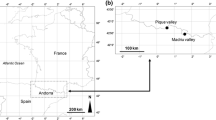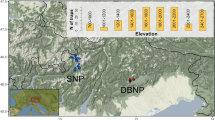Abstract
Understanding the factors that drive species richness and composition at multiple scales is of crucial importance for conservation. Here we evaluated how habitat heterogeneity—at the local and landscape scales—affects the diversity of ants in the Brazilian Cerrado. The Cerrado is a biodiversity hotspot that is characterized as a mosaic of habitats, including savannas of variable structure (the dominant vegetation), grasslands, and forests. We sampled ground-dwelling ants in four habitats, representing a gradient of increasing tree cover and decreasing grass cover. Twelve sites, distributed along two degrees of latitude, were sampled. Our sampling revealed a highly diverse and patchily distributed fauna comprising 150 species (from 44 genera), of which nearly 40% were found in only one site. On average, we found fewer species in the least structurally complex habitat. However, there was relatively little variation in species density among the remaining habitats despite strong differences in vegetation structure among them. Ant species composition varied markedly among sites and such differences were related to variations in vegetation structure but not to inter-site distances (latitude). Similar results were obtained when overall ant species richness (γ diversity) was partitioned additively into three components: α1 (diversity within sampling sites), β1 (diversity among sites within the same habitat type), and β2 (diversity among sites from different habitats). The β2 component contributed much more to γ diversity than did the remaining diversity components, indicating that conservation of the Cerrado ant fauna depends on the maintenance of habitat diversity.




Similar content being viewed by others
References
Anderson M (2001) A new method for non-parametric multivariate analysis of variance. Aust Ecol 26:32–46
Anderson MJ, Willis TJ (2003) Canonical analysis of principal coordinates: a useful method of constrained ordination for ecology. Ecology 84:511–525
Anderson MJ, Crist TO, Chase JM, Vellend M, Inouye BD, Freestone AL, Sanders NJ, Cornell HV, Comita LS, Davies KF, Harrison SP, Kraft NJB, Stegen JC, Swenson NG (2011) Navigating the multiple meanings of β diversity: a roadmap for the practicing ecologist. Ecol Lett 14:19–28
Batalha MA (2011) O Cerrado não é um bioma. Biota Neotropica 11: http://www.biotaneotropica.org.br/v11n11/en/abstract?inventory+bn00111012011
Bestelmeyer BT, Wiens JA (2001) Ant biodiversity in semiarid landscape mosaics: the consequences of grazing vs natural heterogeneity. Ecol Appl 11:1123–1140
Bestelmeyer BT, Agosti D, Alonso LE, Brandão CRF, Brown WL, Delabie JHC, Silvestre R (2000) Field techniques for the study of ground-dwelling ants: an overview, description, and evaluation. In: Agosti D, Majer JD, Alonso LE, Schultz TR (eds) Ants: standard methods for measuring and monitoring biodiversity. Smithsonian Institution Press, Washington, pp 122–144
Böhning-Gaese K (1997) Determinants of avian species richness at different spatial scales. J Biogeogr 24:49–60
Bolton B, Alpert G, Ward PS, Naskrecki P (2007) Bolton’s catalogue of ants of the world: 1758–2005 (CD-ROM). Harvard University Press, MA Cambridge
Bond WJ, Parr CL (2010) Beyond the forest edge: ecology, diversity and conservation of the grassy biomes. Biol Conserv 143:2395–2404
Brandão CRF, Diniz JLM, Silva PR, Albuquerque NL, Silvestre R (2001) The first case of intranidal phragmosis in ants The ergatoid queen of Blepharidatta conops (Formicidae : Myrmicinae) blocks the entrance of the brood chamber. Insect Soc 48:251–258
Brown KS Jr, Gifford DR (2002) Lepidoptera in the Cerrado landscape and the conservation of vegetation, soil, and topographical mosaics. In: Oliveira PS, Marquis RJ (eds) The Cerrados of Brazil: Ecology and Natural History of a Neotropical Savanna. Columbia University Press, New York, pp 201–222
Bullock J (1996) Plants. In: Sutherland WJ (ed) Ecological census techniques. Cambridge University Press, Cambridge, p 352
Cabra-García J, Chacón P, Valderrama-Ardila C (2010) Additive partitioning of spider diversity in a fragmented tropical dry forest (Valle del Cauca, Colombia). J Arachnol 38:192–205
Crist TO, Veech JA, Gering JC, Summerville KS (2003) Partitioning species diversity across landscapes and regions: a hierarchical analysis of alpha, beta, and gamma diversity. Am Nat 162:734–743
Dahms H, Mayr S, Birkhofer K, Chauvat M, Melnichnova E, Wolters V, Dauber J (2010) Contrasting diversity patterns of epigeic arthropods between grasslands of high and low agronomic potential. Basic Appl Ecol 11:6–14
Dunn RR, Agosti D, Andersen AN, Arnan X, Bruhl CA, Cerda X, Ellison AM, Fisher BL, Fitzpatrick MC, Gibb H, Gotelli NJ, Gove AD, Guenard B, Janda M, Kaspari M, Laurent EJ, Lessard JP, Longino JT, Majer JD, Menke SB, McGlynn TP, Parr CL, Philpott SM, Pfeiffer M, Retana J, Suarez AV, Vasconcelos HL, Weiser MD, Sanders NJ (2009) Climatic drivers of hemispheric asymmetry in global patterns of ant species richness. Ecol Lett 12:324–333
Engelbrecht BMJ, Herz HM (2001) Evaluation of different methods to estimate understorey light conditions in tropical forests. J Trop Ecol 17:207–224
Eros T (2007) Partitioning the diversity of riverine fish: the roles of habitat types and non-native species. Freshw Biol 52:1400–1415
Fahr J, Kalko EKV (2011) Biome transitions as centres of diversity: habitat heterogeneity and diversity patterns of West African bat assemblages across spatial scales. Ecography 34:177–195
Folgarait PJ (1998) Ant biodiversity and its relationship to ecosystem functioning: a review. Biodivers Conserv 7:1221–1244
Hölldobler B, Wilson EO (1990) The ants. Belknap Press, Cambridge
Kaspari M (1996) Testing resource-based models of patchiness in four Neotropical litter ant assemblages. Oikos 76:443–454
Kaspari M, Weiser MD (1999) The size-grain hypothesis and interspecific scaling in ants. Funct Ecol 13:530–538
Kaspari M, Ward PS, Yuan M (2004) Energy gradients and the geographic distribution of local ant diversity. Oecologia 140:407–413
Lassau SA, Hochuli DF (2004) Effects of habitat complexity on ant assemblages. Ecography 27:157–164
Lopes CT, Vasconcelos HL (2008) Evaluation of three methods for sampling ground-dwelling ants in the Brazilian cerrado. Neotrop Entomol 37:399–405
McGlynn TP, Fawcett RM, Clark DA (2009) Litter biomass and nutrient determinants of ant density, nest size, and growth in a Costa Rican tropical wet forest. Biotropica 41:234–240
Minchin PR (1987) An evaluation of the relative robustness of techniques for ecological ordination. Vegetatio 69:89–107
Myers N, Mittermeier RA, Mittermeier CG, da Fonseca GAB, Kent J (2000) Biodiversity hotspots for conservation priorities. Nature 403:853–858
Nogueira C, Colli GR, Martins M (2009) Local richness and distribution of the lizard fauna in natural habitat mosaics of the Brazilian Cerrado. Austral Ecol 34:83–96
Oliveira GC, Araújo GM, Barbosa AAA (2009) Florística e zonação de espécies vegetais em veredas no Triângulo Mineiro, Brasil. Rodriguesia 60:1077–1085
Oliveira-Filho AT, Ratter JA (2002) Vegetation physiognomies and woody flora of the Cerrado biome. In: Oliveira PS, Marquis RJ (eds) The Cerrados of Brazil: ecology and natural history of a Neotropical savanna. Columbia University Press, New York, pp 91–120
Paknia O, Pfeiffer M (2011) Hierarchical partitioning of ant diversity: implications for conservation of biogeographical diversity in arid and semi-arid areas. Divers Distrib 17:122–131
Parr CL (2008) Dominant ants can control assemblage species richness in a South African savanna. J Anim Ecol 77:1191–1198
Quinn G, Keough M (2002) Experimental design and data analysis for biologists. Cambridge University Press, Cambridge
Rahbek C (2005) The role of spatial scale and the perception of large-scale species-richness patterns. Ecol Lett 8:224–239
Ribas CR, Schoereder JH (2007) Ant communities, environmental characteristics and their implications for conservation in the Brazilian Pantanal. Biodivers Conserv 16:1511–1520
Ribas CR, Schoereder JH, Pic M, Soares SM (2003) Tree heterogeneity, resource availability, and larger scale processes regulating arboreal ant species richness. Austral Ecol 28:305–314
Rosenzweig ML (1995) Species diversity in space and time. Cambridge Universty Press, Cambridge
R Development Core Team (2011) R: a language and environment for statistical computing. R foundation for statistical computing, Vienna, Austria. ISBN 3-900051-07-0. http://www.R-project.org
Sabo JL, Sponseller R, Dixon M, Gade K, Harms T, Heffernan J, Jani A, Katz G, Soykan C, Watts J, Welter J (2005) Riparian zones increase regional species richness by harboring different, not more, species. Ecology 86:56–62
Sampaio AB, Holl KD, Scariot A (2007) Does restoration enhance regeneration of seasonal deciduous forests in pastures in central Brazil? Restor Ecol 15:462–471
Sarty M, Abbott KL, Lester PJ (2006) Habitat complexity facilitates coexistence in a tropical ant community. Oecologia 149:465–473
Silva RR, Brandão CRF, Silvestre R (2004) Similarity between cerrado localities in Central and Southeastern Brazil based on the dry season bait visitors ant fauna. Stud Neotrop Fauna Environ 39:191–199
Silva JAA, Nobre AD, Manzatto CV, Joly CA, Rodrigues RR, Skorupa LA, Nobre CA, Ahrens S, May PH, SÁ TDA, Cunha MC, Rech Filho EL (2011) O Código Florestal e a Ciência: Contribuições para o diálogo. Sociedade Brasileira para o Progresso da Ciência, Academia Brasileira de Ciências
Solomon SE, Lopes CT, Mueller UG, Rodrigues A, Sosa-Calvo J, Schultz TR, Vasconcelos HL (2011) Nesting biology and fungiculture of the fungus-growing ant, Mycetagroicus cerradensis: new light on the origin of higher-attine agriculture. J Insect Sci 11:12. http://insectscience.org/11.12
Tews J, Brose U, Grimm V, Tielborger K, Wichmann MC, Schwager M, Jeltsch F (2004) Animal species diversity driven by habitat heterogeneity/diversity: the importance of keystone structures. J Biogeogr 31:79–92
Vasconcelos HL, Vilhena JMS (2006) Species turnover and vertical partitioning of ant assemblages in the Brazilian Amazon: a comparison of forests and savannas. Biotropica 38:100–106
Vasconcelos HL, Araujo BB, Mayhe-Nunes AJ (2008) Patterns of diversity and abundance of fungus-growing ants (Formicidae: Attini) in areas of the Brazilian Cerrado. Rev Bras Zool 25:445–450
Vasconcelos HL, Vilhena JMS, Facure KG, Albernaz A (2010) Patterns of ant species diversity and turnover across 2000 km of Amazonian floodplain forest. J Biogeogr 37:432–440
Veech JA, Crist TO (2006). PARTITION: software for hierarchical additive partitioning of species diversity. http://zoology.muohio.edu/partition
Veech JA, Summerville KS, Crist TO, Gering JC (2002) The additive partitioning of species diversity: recent revival of an old idea. Oikos 99:3–9
Wagner HH, Wildi O, Ewald KC (2000) Additive partitioning of plant species diversity in an agricultural mosaic landscape. Landsc Ecol 15:219–227
Whittaker RH, Levin SA (1977) The role of mosaic phenomena in natural communities. Theor Popul Biol 12:117–139
Acknowledgments
We are grateful to Gabriela P. Camacho, Laura V. B. Silva, Fabiane Mundim, Cauê T. Lopes and Alan N. da Costa for assistance with the field and laboratory work. We also thank Dr. Thomas O. Crist and an anonymous reviewer for the very useful suggestions made on earlier versions of the manuscript, and Adriano Melo for his help with the R software. Logistical support was provided by the Universidade Federal de Uberlândia (UFU), Faber-Castell S.A. and Parque Estadual da Serra de Caldas Novas (PESCAN). Financial support was provided by grants from the Brazilian Council of Research and Scientific Development (CNPq grants 472972/2008-1 and 143112/2008-2), and FAP-DF (Projeto PRONEX 2009/00087-3).
Author information
Authors and Affiliations
Corresponding author
Rights and permissions
About this article
Cite this article
Pacheco, R., Vasconcelos, H.L. Habitat diversity enhances ant diversity in a naturally heterogeneous Brazilian landscape. Biodivers Conserv 21, 797–809 (2012). https://doi.org/10.1007/s10531-011-0221-y
Received:
Accepted:
Published:
Issue Date:
DOI: https://doi.org/10.1007/s10531-011-0221-y




